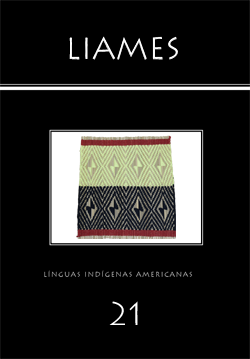Abstract
This paper describes the main contrasts of the count/mass distinction of the Kheuól do Uaçá nouns. Kheuól do Uaçá is a French-based creole language spoken by two distinct indigenous peoples, Karipuna and Galibi-Marworno, who share the same territory (Terras Indígenas do Uaçá and Juminã) at the Oiapoque municipality, Amapá state, Brazil, in the French Guiana border. Both varieties of the Kheuól do Uaçá are underdocumented, especially the Galibi-Marworno described in this paper. Almost all nouns combine with numerals (kwak ‘flour’ is the only exception); almost all quantifiers and quantity modifiers show no restriction in combination with notionally count and mass nouns (un de thoa ‘some’ only combine with notionally count nouns); and all nouns can be pluralized with the plural definite article -iela. Whereas almost all nouns can be counted, the relevant contrast is held in the capacity of notionally mass nouns to be open for unbounded denotations. This capacity can be captured by the fact that notionally mass nouns recover the third person singular pronoun i/li as anaphora for sortal names in bare noun phrases contexts (neutral for number); on the other hand, notionally count nouns recover the third person plural pronoun ie as anaphora at the same contexts.
References
Aboh, Enoch Olade; DeGraff, Michel (2014). Some notes on bare noun phrases in Haitian Creole and in Gungbe: a transatlantic Sprachbund perspective. In Tor A. Afarli; Brit Maehlum (eds.). The Sociolinguistics of Gramma, pp. 203-236. Amsterdam/Philadelphia: John Benjamins. https://doi.org/10.1075/slcs.154.11abo
Alleyne, Mervyn; Ferreira, Jo-Anne (2007). Comparative perspectives on the origins, development and structure of Amazonian (Karipúna) French Creole. In Magnus Huber; Viveka Vellupilai (eds). Synchronic and diachronic perspectives on contact languages, pp. 325-357, v. 32. Amsterdam/Philadelphia: JohnBenjamins. http://doi.org/10.1075/cll.32.19fer
Cavlak, Iuri (2016). Aspectos da colonização na Guiana Francesa e no Amapá: visões comparadas e imbricações históricas. Revista de Estudos e Pesquisas sobre as Américas 10(2): 158-181. https://doi.org/10.21057/repam.v10i2.21893
http://periodicos.unb.br/index.php/repam/issue/download/1310/repam.v10i2#page=157
Barner, David; Snedeker, Jesse (2005). Quantity judgments and individuation: evidence that mass nouns count. Cognition, 97(1): 41-66. https://doi.org/10.1016/j.cognition.2004.06.009
Chierchia, Gennaro (1998) Plurality of mass nouns and the notion of 'semantic parameter'. In Susan Rothstein (ed.). Events and Grammar, pp. 53-103. Berlin, Alemanha: Springer (Kluwer). https://doi.org/10.1007/978-94-011-3969-4_4
Chierchia, Gennaro (2010). Mass nouns, vagueness and semantic variation. Synthese 174(1): 99-149. https://doi.org/10.1007/s11229-009-9686-6
Gallois, Dominique Tilkin; Grupioni, Denise Fajardo (2003). Povos indígenas no Amapá e Norte do Pará: quem são, onde estão, quantos são, como vivem e o que pensam?. São Paulo, SP: Instituto Iepé. http://www.institutoiepe.org.br/media/livros/livro_povos_indigenas_no_AP_e_N_do_PA-sem_fotos.pdf
Instituto Socioambiental (2020a). Povos Indígenas no Brasil. Disponível em (https://pib.socioambiental.org/pt/Povo:Karipuna_do_Amap%C3%A1) (Acesso 18/09/2020).
Instituto Socioambiental. (2020b) Povos Indígenas no Brasil. Disponível em (https://pib.socioambiental.org/pt/Povo:Galibi_Marworno) (Acesso 18/09/2020).
Lima, Suzi; Rothstein, Susan (2016). The count/mass distinction questionnaire. (ms.).
Löbner, Sebastian (1985). Definites. Journal of semantics 4(4): 279-326. https://doi.org/10.1093/jos/4.4.279
Löbner, Sebastian (2011). Concept types and determination. Journal of semantics 28(3): 279-333. https://doi.org/10.1093/jos/ffq022
Paul, Moles; Zribi-Hertz, Anne; Glaude, Herby. Countability and number without number inflection: evidence from Haitian Creole (a aparecer). In Jenny Doetjes; Patricia Cabredo Hofherr (eds.). Handbook of grammatical number. Oxford, Reino Unido: Oxford University Press https://www.sfl.cnrs.fr/sites/default/files/images/countabilitynumber.vf_.pdf
Pelletier, Francis; Schubert, Lenhart (1989). Mass expressions. In Dov Gabbay; Franz Guenthner (eds.). Handbook of philosophical logic. (Volume IV), pp.327-408. Dordrecht, Holanda: Reidel. https://doi.org/10.1007/978-94-009-1171-0_4
Rothstein, Susan (2010). Counting and the mass/count distinction. Journal of semantics 27(3): 343-397. https://doi.org/10.1093/jos/ffq007
Silva, Gutemberg; Rückert, Aldomar (2009). A fronteira Brasil-França: mudança de usos político-territoriais na fronteira entre Amapá (BR) e Guiana Francesa (FR). Confins. Revue franco-brésilienne de géographie/Revista franco-brasilera de geografia (7): 1-21. https://doi.org/10.4000/confins.6040. http://confins.revues.org/6040
Silva, Jaciara da; Santos, Nordevaldo dos; Charles, João; Santos, Gélsama Mara dos; Silva, Glauber Romling da. Campetela, Cilene; Costa, Ingrid (orgs.) (2019a). Nate konétmã dji thavai - Liv djidatk dji methés-iela. Macapá, AP: Editora Unifap. https://www2.unifap.br/editora/files/2019/12/nate-konetma-dji-thavai.pdf
Silva, Jaciara da; Santos, Nordevaldo dos; Charles, João; Santos, Gélsama Mara dos; Silva, Glauber Romling da. Campetela, Cilene; Costa, Ingrid (orgs.) (2019b). No Liv dji ixtwa Galibi Marworno - Liv paradjidatk dji methés-iela. Macapá, AP: Editora Unifap. https://www2.unifap.br/editora/files/2019/12/no-liv-dji-ixtwa-balibi-marworno.pdf
Stenzel, Kristine; Lüpke, Friederike; Cabalzar, Flora; Chacon, Thiago; Cruz, Aline da; Franchetto, Bruna; Guerreiro, Antonio; Meira, Sérgio; Silva, Glauber Romling da; Silva, Wilson; Storto, Luciana; Valentino, Leonor; Voort, Hein van der; Watson, Rachel (no prelo). Comparing Multilingualism in Lowland South America and Western Africa. Anthropological Linguistics.
Tassinari, Antonella. E. A. (1998). Karipunas" e" Brasileiros": a trajetória de dois termos. Uma contribuição à história indígena da região do Baixo Rio Oiapoque. XXI Encontro Anual da ANPOCS, pp. 1-32. Caxambu, MG. https://www.anpocs.com/index.php/encontros/papers/22-encontro-anual-da-anpocs/gt-20/gt04-11/5060-atassinari-karipunas/file
Tobler, S. Joy (1983). The Grammar of Karipúna Creole (n. 10). Brasília, DF: Summer Institute of Linguistics. https://www.sil.org/system/files/reapdata 97/87/12/9787124047609139753004831007530933030/KAGram.pdf

This work is licensed under a Creative Commons Attribution-NonCommercial 4.0 International License.
Copyright (c) 2021 Glauber Romling da Silva


